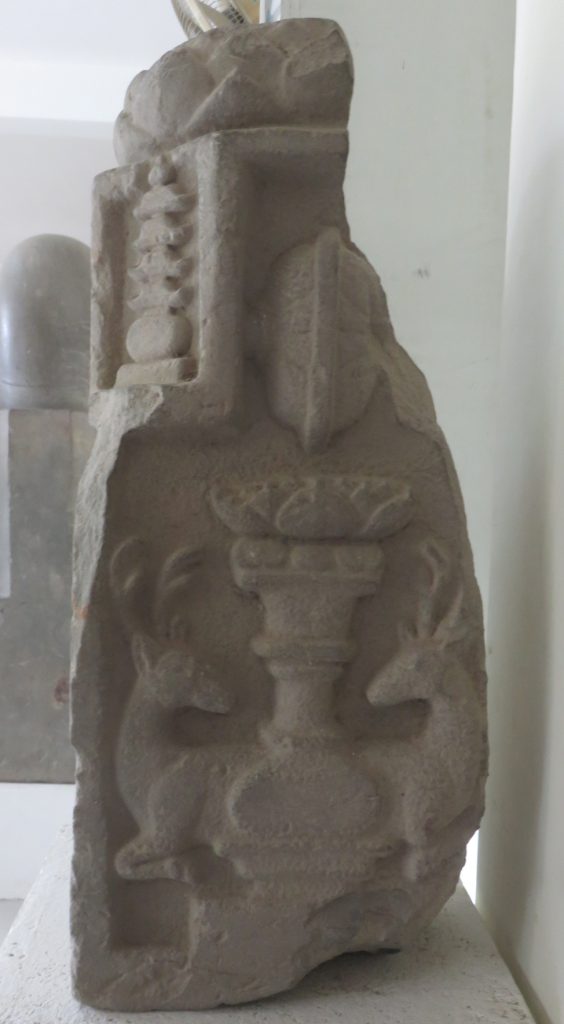តាមរយៈទិន្នន័យនៃការស្រាវជ្រាវកន្លងមក បានបង្ហាញភស្តុតាងជាច្រើនអំពីឥទ្ធិពលព្រះពុទ្ធសាសនាមកលើសង្គមខ្មែរនៅសម័យដំបូងៗ ជាពិសេស គឺសម័យហ្វូណនតែម្តង ដែលគេដឹងតាមកំណត់ហេតុចិនថានៅរវាងចុងស.វ.ទី៥ ព្រះរាជាខ្មែរមួយអង្គព្រះនាមកៅណ្ឌិន្យជ័យវរ្ម័នបានបញ្ជូនភិក្ខជនជាតិឥណ្ឌាចំនួនមួយអង្គព្រះនាមសាក្យនាគសេន យកគ្រឿងតង្វាយទៅថ្វាយស្តេចចិននៅរវាងគ.ស.៤៨៤។ ក្រោយមក គេបានរកឃើញព្រះពុទ្ធរូបជាច្រើននៅតំបន់ភាគខាងត្បូងប្រទេសកម្ពុជា ជាពិសេស គឺស្ថានីយអង្គរបុរី និងស្ថានីយមួយចំនួននៅខេត្តកំពង់ស្ពឺ។ ក្រៅពីនេះ មានភស្តុតាងសិលាចារឹកជាច្រើន ដែលបញ្ជាក់អំពីវត្តមានព្រះពុទ្ធសាសនានៅកម្ពុជាសម័យដំបូងដែលទាក់ទងនឹងព្រះពុទ្ធសាសនានិកាយហិនយានដូចជា សិលាចារឹកតាព្រហ្មទន្លេបាទី (K.40) សិលាចារឹកនគររាជសីមា (K.388) សិលាចារឹកវត្តស្រះឈូក (Ka.29)។ល។ លុះមកដល់ស.វ.ទី៧ គេបានរកឃើញសិលាចារឹករៀបរាប់ពីព្រះពុទ្ធសាសនាមហាយានជាបន្តបន្ទាប់ ដូចករណីសិលាចារឹកប្រាសាទបី (K.163) ជាដើម។៣ ដោយឡែក នៅក្នុងអត្ថបទស្រាវជ្រាវខ្លីនេះ យើងនឹងបង្ហាញអំពីភស្តុតាងមួយនៃព្រះពុទ្ធសាសនានៅក្នុងសង្គមកម្ពុជាសម័យដំបូងដូចគ្នា តែផ្តោតទៅលើការសិក្សាថ្មគោលព្រះពុទ្ធសាសនាមួយកំពុងដាក់តាំងបង្ហាញនៅសារមន្ទីរអង្គរបុរី ខេត្តតាកែវ ដែលជាសិល្បៈដ៏កម្របំផុតនៅក្នុងសិល្បៈខ្មែរសម័យដំបូងៗ។
ថ្មគោលព្រះពុទ្ធសាសនានេះ គេបានរកឃើញនៅតំបន់អង្គរបុរី ជាប្រភេទថ្មគោលឆ្លាក់អំពីថ្មភក់មួយដុំ មានរាងបួនជ្រុងទ្រវែង (បែកជ្រុងខ្លះ) ហើយស្ថានភាពសព្វថ្ងៃនៅសល់រូបរាងចម្លាក់ច្បាស់លាស់ចំនួនពីរជ្រុង ដែលអាចឱ្យយើងស្វែងយល់អំពីចម្លាក់នៅលើថ្មគោលនេះបាន។ សព្វថ្ងៃ ថ្មគោលនេះគេបានចុះលេខសម្គាល់បញ្ជីវត្ថុលេខ តកអ.ក.០១៣។ នៅជ្រុងម្ខាងនៃថ្មគោលនេះ យើងឃើញមានបង្ហាញចម្លាក់ព្រះពុទ្ធរូប ឬព្រះពោធិសត្វមានព្រះហស្តឆ្វេងកាន់ផ្កាឈូក និងកាយវិការឈរកាច់ចង្កេះ ដែលឥណ្ឌានិយមហៅរាងនេះថា “ត្រិភង្គ” (Tribhaṅga)។ កាយវិការឈរកាច់ចង្កេះក្នុងទម្រង់ត្រិភង្គបែបនេះ យើងធ្លាប់ប្រទះឃើញរូបជាច្រើនទៀតនៅក្នុងសិល្បៈខ្មែរសម័យមុនអង្គរ ឧទាហរណ៍ ព្រះពុទ្ធរូបមួយរកឃើញនៅវត្តរំលក ស្រុកអង្គរបុរី ខេត្តតាកែវ (សព្វថ្ងៃតាំងនៅសារមន្ទីរជាតិភ្នំពេញ)។ ក្រៅពីរូបព្រះពោធិសត្វឈរកាច់ចង្កេះ យើងឃើញមានចេតិយចំនួនពីរឆ្លាក់នៅខាងលើអមសងខាងព្រះពោធិសត្វ ដែលចម្លាក់ចេតិយប្រភេទនេះគេធ្លាប់ឃើញមាននៅសិល្បៈឥណ្ឌា និងសិល្បៈផ្សេងៗទៀតក្នុងតំបន់អាស៊ីអាគ្នេយ៍ ដូចជា សិល្បៈចាម្ប៉ា សិល្បៈទ្វារវតី សិល្បៈស្រីក្សេត្រ។
ដោយឡែក នៅជ្រុងម្ខាងទៀតនៃថ្មគោល យើងឃើញមានចម្លាក់ថូផ្កានៅចំកណ្តាល និងអមដោយរូបសត្វក្តាន់ចំនួនពីរឆ្លាក់នៅអមសងខាងថូផ្កា ហើយជាពិសេសនោះនៅផ្នែកខាងលើ មានចម្លាក់មួយដែលយើងគិតថាជារូបកងចក្រ ឬធម្មចក្រ។ រូបធម្មចក្រនេះទំនងជារូបភាពមួយតំណាងឱ្យព្រះពុទ្ធអង្គ ក្នុងវេលាមួយនៃការទេសនាដំបូងរបស់ទ្រង់នៅសួនក្តាន់ នៃក្រុងសាន៌ថ (Sarnath)។ សូមបញ្ជាក់ថា នៅក្នុងសិល្បៈឥណ្ឌានាសម័យដំបូងៗគេមិននិយមឆ្លាក់រូបព្រះពុទ្ធអង្គក្នុងទម្រង់ជាមនុស្សឡើយ ពោល គឺគេនិយមឆ្លាក់រូបអ្វីមួយតំណាង ដូចជា ដើមពោធិ ចេតិយ ធម្មចក្រ ពុទ្ធបាទ។ល។ ដែលប្រការនេះគេនិយមហៅជាភាសាអង់គ្លេសថា “Aniconism”។ ការគោរពបូជាទៅលើវត្ថុតំណាងទាំងនោះ អាចបង្ហាញពីទីតាំងជាក់លាក់ណាមួយដែលទាក់ទងនឹងព្រះពុទ្ធសាសនា ឬជួនកាលបង្ហាញអំពីដំណើរជីវិតរបស់ព្រះពុទ្ធអង្គតាំងពីទ្រង់យោងយកកំណើតរហូតដល់ទ្រង់ចូលបរិនិព្វាន។ ឧទាហរណ៍ រូបលេខ៩ ជាចម្លាក់នៅក្នុងសិល្បៈឥណ្ឌា ដែលបង្ហាញអំពីពុទ្ធបរិស័ទកំពុងគោរពបូជាព្រះពុទ្ធអង្គក្នុងទម្រង់ជាកងចក្រ ឬធម្មចក្រ និងមានក្តាន់ពីរនៅខាងក្រោមកងចក្រនោះ ដូចនឹងរូបចម្លាក់នៅលើថ្មគោលដែលយើងកំពុងលើកមកសិក្សានេះដែរ។
ជារួមមក ថ្មគោលដែលរកឃើញនៅតំបន់អង្គរបុរីនេះ គឺជាតឹកតាងមួយដែលបានបង្ហាញ ឱ្យឃើញពីការសាយភាយដំបូងៗនៃឥទ្ធិពលព្រះពុទ្ធសាសនាពីអារ្យធម៌ឥណ្ឌាចូលមកសង្គមខ្មែរ ហើយតាមរយៈតឹកតាងនេះ យើងអាចកត់សម្គាល់បានថា បុរាណដ្ឋានអង្គរបុរីដែលជាអតីតរាជធានីរបស់ហ្វូណន គឺជារដ្ឋមួយក្នុងចំណោមរដ្ឋសំខាន់ៗដែលទទួលឥទ្ធិពលនេះយ៉ាងធំធេង ដូចយើងឃើញការបង្ហាញចម្លាក់ចេតិយពីរនៅអមសងខាងព្រះពុទ្ធអង្គជាតឹកតាងស្រេច។ ម្យ៉ាងវិញទៀត គំនិតនៃការគោរបូជាទៅលើវត្ថុតំណាងព្រះពុទ្ធអង្គ និងចម្លាក់ព្រះពុទ្ធឬពោធិសត្វដែលឈរកាច់ចង្កេះ (ត្រិភង្គ) គឺជាការបង្ហាញឱ្យឃើញពីការទទួលឥទ្ធិពលពីឥណ្ឌាយ៉ាងសំខាន់នៅក្នុងសិល្បៈដំបូងៗរបស់ខ្មែរ៕
————————————————————————–,
An image of the early influence of Buddhism on Cambodian society
(Case Study of Buddhist Pillars at Angkor Borei Museum)
According to the past research has shown much evidence of the influence of Buddhism on Cambodian society in the early period, especially the Funan period, which is known from Chinese records that between the end of the 5th century, the Khmer kings Kaundin Jayavarman sent an Indian monk named Sakya Neak Sen offerings to the Chinese king between 484 C.E. Later, many Buddha statues were found in the southern part of Cambodia, especially the Angkor Borei site and some sites in Kampong Speu province. In addition, there are many inscriptions confirming the presence of Buddhism in early Cambodia related to Hinayana Buddhism, such as the Ta Prohm inscription, Tonle Bati (K.40), the Nakhon Ratchasima inscription (K.388), and the Srah Chhouk pagoda inscription. (Ka.29) etc. By the 7th century, inscriptions describing Mahayana Buddhism were found in succession, as in the case of the Three Temple Inscriptions (K.163). In particular, this article will illustrate the evidence of Buddhism in the same early Cambodian society, but focusing on the study of a Buddhist Pillar is on an indication at the Angkor Borei Museum, Takeo Province that is a very rare art in early Khmer art.
This Buddhist pillar was found in Angkor Borei, a type of pillar carved on sandstone with a rectangular shape and the current situation remains two clear sculptural at the side of the pillar that allows us to recognize the sculpture on this pillar. This pillar was presently registered as a list of number objects (តកអ.ក.០១៣). At the side of the pillar indicated a Buddha statue or Bodhisattva with his left hand holding a lotus flower and a standing body position gesture, which the Indians call the “Tribhaṅga”. this gesture, we have found many other images in pre-Angkorian Khmer art, for instance, a Buddha statue found at Wat Romlok, Angkor Borei, Takeo province (display at National Museum of Phnom Penh).
In addition to the standing Bodhisattva, we see two stupas carved on either side of the Bodhisattva, which is found in Indian art and other arts in Southeast Asia, such as Champa, Dvaravati, and Srei Kaset Art.
Besides, on the other side of the pillar, there is a vase in the center accompanied by two deer carved on either side of the vase, and especially at the top, there is a sculpture that we think is Chakra or Dharmachakra. This Dharmachakra is likely to represent an image of the Buddha during one of his first sermons at the Deer Park in Sarnath. It should be noted that in early Indian art, it was not popular to carve a Buddha image in the form of a human, that is, it was popular to carve something representative, such as tree, stupa, Dhammachakra, Buddha, etc. This is often called “Aniconism” in English. Worship of these objects may indicate a specific position associated with Buddhism, or sometimes the life of the Buddha from his birth to his death. For instance, sculptures in Indian art depicting Buddhists worshiping the Buddha in the form of a Chakra or Dharmachakra, and having two deer at the bottom of that Chakra, just like the stone sculpture we are studying.
Overall, the Pillar found in the Angkor Borei area is evidence that illustrated the early influence of Buddhists from Indian civilization into Cambodian society. Based on this evidence we can note that the Angkor Borei site, as an ancient capital of Funan is one of the major states that has been greatly affected by this, as we can see from the indication of two stupas on either side of the Buddha.
អត្ថបទដើម៖ លោក លាក់ ស៊ីផាន់ណា










